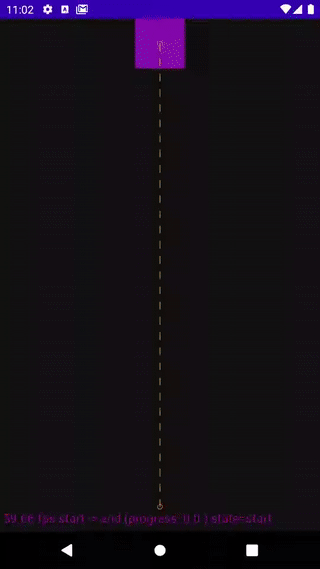Activityclass SwipeHandlerActivity : AppCompatActivity(R.layout.activity_swipe_handler){
override fun onSaveInstanceState(outState: Bundle) {
super.onSaveInstanceState(outState)
outState.putBundle("Foo", findViewById<MotionLayout>(R.id.the_motion_layout).transitionState)
}
override fun onCreate(savedInstanceState: Bundle?) {
super.onCreate(savedInstanceState)
savedInstanceState?.getBundle("Foo")?.let(findViewById<MotionLayout>(R.id.the_motion_layout)::setTransitionState)
}
}
Layout<?xml version="1.0" encoding="utf-8"?>
<androidx.constraintlayout.motion.widget.MotionLayout xmlns:android="http://schemas.android.com/apk/res/android"
xmlns:app="http://schemas.android.com/apk/res-auto"
android:layout_width="match_parent"
android:layout_height="match_parent"
app:layoutDescription="@xml/activity_swipe_handler_scene"
android:id="@+id/the_motion_layout"
app:motionDebug="SHOW_ALL">
<View
android:id="@+id/touchAnchorView"
android:background="#8309AC"
android:layout_width="64dp"
android:layout_height="64dp"
app:layout_constraintStart_toStartOf="parent"
app:layout_constraintEnd_toEndOf="parent"
app:layout_constraintTop_toTopOf="parent" />
</androidx.constraintlayout.motion.widget.MotionLayout>
Scene<?xml version="1.0" encoding="utf-8"?>
<MotionScene
xmlns:android="http://schemas.android.com/apk/res/android"
xmlns:motion="http://schemas.android.com/apk/res-auto">
<Transition
motion:constraintSetEnd="@+id/end"
motion:constraintSetStart="@id/start"
motion:duration="1000">
<OnSwipe
motion:touchAnchorId="@id/imageView"
motion:dragDirection="dragUp"
motion:touchAnchorSide="top" />
</Transition>
<ConstraintSet android:id="@+id/start">
</ConstraintSet>
<ConstraintSet android:id="@+id/end">
<Constraint
android:layout_height="250dp"
motion:layout_constraintStart_toStartOf="@+id/textView2"
motion:layout_constraintEnd_toEndOf="@+id/textView2"
android:layout_width="250dp"
android:id="@+id/imageView"
motion:layout_constraintBottom_toTopOf="@+id/textView2"
android:layout_marginBottom="68dp" />
</ConstraintSet>
</MotionScene>

The motion layout stays at its start state after configuration change
I ended up creating these extension functions
fun MotionLayout.restoreState(savedInstanceState: Bundle?, key: String) {
viewTreeObserver.addOnGlobalLayoutListener(object : ViewTreeObserver.OnGlobalLayoutListener {
override fun onGlobalLayout() {
doRestore(savedInstanceState, key)
viewTreeObserver.removeOnGlobalLayoutListener(this)
}
})
}
private fun MotionLayout.doRestore(savedInstanceState: Bundle?, key: String) =
savedInstanceState?.let {
val motionBundle = savedInstanceState.getBundle(key) ?: error("$key state was not saved")
setTransition(
motionBundle.getInt("claptrap.motion.startState", -1)
.takeIf { it != -1 }
?: error("Could not retrieve start state for $key"),
motionBundle.getInt("claptrap.motion.endState", -1)
.takeIf { it != -1 }
?: error("Could not retrieve end state for $key")
)
progress = motionBundle.getFloat("claptrap.motion.progress", -1.0f)
.takeIf { it != -1.0f }
?: error("Could not retrieve progress for $key")
}
fun MotionLayout.saveState(outState: Bundle, key: String) {
outState.putBundle(
key,
bundleOf(
"claptrap.motion.startState" to startState,
"claptrap.motion.endState" to endState,
"claptrap.motion.progress" to progress
)
)
}
Then I called them like this:
onCreate, onCreateView
if (savedInstanceState != null) {
binding.transactionsMotionLayout.restoreState(savedInstanceState, MOTION_LAYOUT_STATE_KEY)
}
onSaveInstanceState binding.transactionsMotionLayout.saveState(outState, MOTION_LAYOUT_STATE_KEY)
This resulted in the expected behavior for both MotionLayouts in Activitys, and MotionLayouts inside Fragments. But I'm not happy with the amount of code required, so if anyone could suggest a cleaner solution, I would be really happy to hear that :)
The TransitionLayout is interactive at this point. Called when a drawer is about to start a transition. Note. startId may be -1 if starting from an "undefined state" int: the id of the start state (or ConstraintSet).
Use MotionLayout when animating UI elements the user will interact with It’s important to realize that motion is here to serve a purpose — it should not be simply a gratuitous special effect in your application; it should be used to help the user understand what your application is doing.
Animation transitions allow the state machineThe set of states in an Animator Controller that a character or animated GameObject can be in, along with a set of transitions between those states and a variable to remember the current state.
This is done by simply adding ConstraintLayout 2.0 to your Gradle file: MotionLayout is a subclass of ConstraintLayout — as such, you can treat it like a normal layout. To transform an existing ConstraintLayout into a MotionLayout is as easy as replacing the class name from:
I don't see why you haven't done that but you need to extend MotionLayout to properly save the view state.
Your current solution (aside from requiring extra handling in activity and fragment layer) will fail in case of detachable fragments because they handle views save state internally without actually populating savedInstanceState (quite confusing I know).
open class SavingMotionLayout @JvmOverloads constructor(
context: Context, attrs: AttributeSet? = null, defStyleAttr: Int = 0
) : MotionLayout(context, attrs, defStyleAttr) {
override fun onSaveInstanceState(): Parcelable {
return SaveState(super.onSaveInstanceState(), startState, endState, targetPosition)
}
override fun onRestoreInstanceState(state: Parcelable?) {
(state as? SaveState)?.let {
super.onRestoreInstanceState(it.superParcel)
setTransition(it.startState, it.endState)
progress = it.progress
}
}
@kotlinx.android.parcel.Parcelize
private class SaveState(
val superParcel: Parcelable?,
val startState: Int,
val endState: Int,
val progress: Float
) : Parcelable
}
You will need to use this class in your XML instead of MotionLayout however its less prone to errors and will respect proper view state saving mechanisms so you do not need to add any extra code to activities or fragments anymore.
If you want to disable saving you can do it with android:saveEnabled="false" in XML or isSaveEnabled = false in code.
If you love us? You can donate to us via Paypal or buy me a coffee so we can maintain and grow! Thank you!
Donate Us With